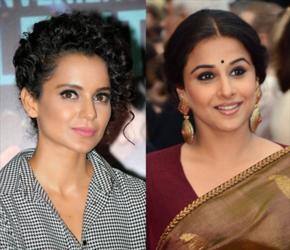Social Realism: Bollywood reflects on its women

She’s no longer the docile cow; subservient, quiet, omnipresent, yet barely there. The new Bollywood heroine isn’t just the maa or the behen or even the biwi anymore; she’s actually as good as the hero himself – considering that the hero has always been the bench mark of, well, everything, as far as hindi films are concerned.
The focus of the lens has now shifted to the woman; Mind you, she still is the skimpily clad ‘item girl’, but she’s also the fierce Vidya from Kahaani, the seductress Beghum Para from Dedh Ishqiyaan, or the innocent yet adventurous Rani from Queen. These characters are well written and performed; best of all, these characters have a certain level of depth to them, and are not just frivolous or empty.
I am personally, quite impressed by this change, which is not to say that women have managed to achieve an entirely new status in the industry. Item songs and item girls are still the most popular marketing tool for movie makers, right across the board, the most recent being Sunny Leone’s Baby Doll for the film, Ragini MMS. But there’s a sense of attraction surrounding this new woman of Hindi cinema. It is probably a reflection of the changing role of the urban woman, or maybe a hope that the urban woman will change.
Busier lifestyles, forward thinking, open mind sets and sexual awareness, are all contributors to this new wave in Hindi filmmaking. I remember writing about a new wave in Hindi cinema, as far as the content of the film was concerned. Women centric movies too, I think are a part of that new wave. Social realism is the main focus of these films, and the urban woman is a significant part of that social reality.
What is amazing is that women centric films work; these strong female characters are loved and appreciated. Take Kahaani for example; Vidya Balan carried that film on her shoulders. Yes, Nawazudin Siddique played an important role, but he just provided good support, the star of the film was Ms. Balan.
Even films like, Ishaqzaade, Gangs of Wasseypur, Shanghai, Talaash, Chak de India, all of which have strong male characters, had strong female leads too, without whom, I feel, the films would have lacked quite a bit of substance.
It is more than likely, that the new woman of Bollywood is a reflection of the change in the attitude of women as well as about women. Especially, post the December 16th rape which shook the entire nation. It was as if something clicked in everyone’s minds, men and women. People are more cautious now, but also more aware. Women are aware of themselves, their sexuality, their being as a whole, and cinema reflects that.
These new women centric movies focus on characters that can hold their own. They’re no heroes of the past, but heroines of the present. Although the higher level of attention given to female characters does surprise me, as far as Bollywood is concerned. It was impossible to think of mainstream Hindi films without a male protagonist, let alone that would be accepted. A film industry, so heavily reliant on the need for a male protagonist has certainly done well in changing focus.
The focus here is particularly on mainstream films because art house Hindi films have been women centric; films like Hazaar Chaurasi Ki Maa, Arth, Khamosh Paani and B.A. Pass, are all examples of such films. Mainstream cinema is slowly catching up.
That said, the sudden change still intrigues me. Why things are changing are somewhat of a no brainer; though. I do hope the change lasts forever.
She’s no longer the docile cow; subservient, quiet, omnipresent, yet barely there. The new Bollywood heroine isn’t just the maa or the behen or even the biwi anymore; she’s actually as good as the hero himself – considering that the hero has always been the bench mark of, well, everything, as far...
She’s no longer the docile cow; subservient, quiet, omnipresent, yet barely there. The new Bollywood heroine isn’t just the maa or the behen or even the biwi anymore; she’s actually as good as the hero himself – considering that the hero has always been the bench mark of, well, everything, as far as hindi films are concerned.
The focus of the lens has now shifted to the woman; Mind you, she still is the skimpily clad ‘item girl’, but she’s also the fierce Vidya from Kahaani, the seductress Beghum Para from Dedh Ishqiyaan, or the innocent yet adventurous Rani from Queen. These characters are well written and performed; best of all, these characters have a certain level of depth to them, and are not just frivolous or empty.
I am personally, quite impressed by this change, which is not to say that women have managed to achieve an entirely new status in the industry. Item songs and item girls are still the most popular marketing tool for movie makers, right across the board, the most recent being Sunny Leone’s Baby Doll for the film, Ragini MMS. But there’s a sense of attraction surrounding this new woman of Hindi cinema. It is probably a reflection of the changing role of the urban woman, or maybe a hope that the urban woman will change.
Busier lifestyles, forward thinking, open mind sets and sexual awareness, are all contributors to this new wave in Hindi filmmaking. I remember writing about a new wave in Hindi cinema, as far as the content of the film was concerned. Women centric movies too, I think are a part of that new wave. Social realism is the main focus of these films, and the urban woman is a significant part of that social reality.
What is amazing is that women centric films work; these strong female characters are loved and appreciated. Take Kahaani for example; Vidya Balan carried that film on her shoulders. Yes, Nawazudin Siddique played an important role, but he just provided good support, the star of the film was Ms. Balan.
Even films like, Ishaqzaade, Gangs of Wasseypur, Shanghai, Talaash, Chak de India, all of which have strong male characters, had strong female leads too, without whom, I feel, the films would have lacked quite a bit of substance.
It is more than likely, that the new woman of Bollywood is a reflection of the change in the attitude of women as well as about women. Especially, post the December 16th rape which shook the entire nation. It was as if something clicked in everyone’s minds, men and women. People are more cautious now, but also more aware. Women are aware of themselves, their sexuality, their being as a whole, and cinema reflects that.
These new women centric movies focus on characters that can hold their own. They’re no heroes of the past, but heroines of the present. Although the higher level of attention given to female characters does surprise me, as far as Bollywood is concerned. It was impossible to think of mainstream Hindi films without a male protagonist, let alone that would be accepted. A film industry, so heavily reliant on the need for a male protagonist has certainly done well in changing focus.
The focus here is particularly on mainstream films because art house Hindi films have been women centric; films like Hazaar Chaurasi Ki Maa, Arth, Khamosh Paani and B.A. Pass, are all examples of such films. Mainstream cinema is slowly catching up.
That said, the sudden change still intrigues me. Why things are changing are somewhat of a no brainer; though. I do hope the change lasts forever.









Leave a Comment